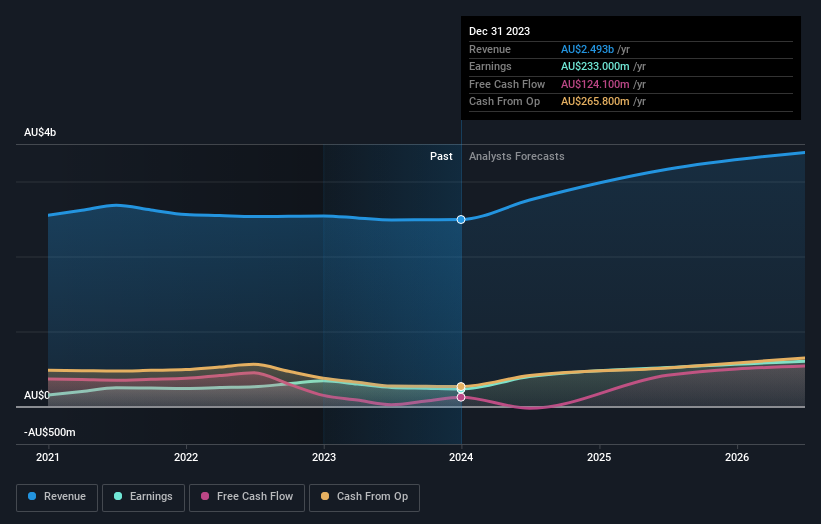Painful week for individual investors invested in Treasury Wine Estates Limited (ASX:TWE) after 7.3% drop, institutions also suffered losses
Key Insights
The considerable ownership by individual investors in Treasury Wine Estates indicates that they collectively have a greater say in management and business strategy
The top 25 shareholders own 37% of the company
A look at the shareholders of Treasury Wine Estates Limited (ASX:TWE) can tell us which group is most powerful. We can see that individual investors own the lion's share in the company with 60% ownership. In other words, the group stands to gain the most (or lose the most) from their investment into the company.
Following a 7.3% decrease in the stock price last week, individual investors suffered the most losses, but institutions who own 40% stock also took a hit.
Let's take a closer look to see what the different types of shareholders can tell us about Treasury Wine Estates.
Check out our latest analysis for Treasury Wine Estates
What Does The Institutional Ownership Tell Us About Treasury Wine Estates?
Institutional investors commonly compare their own returns to the returns of a commonly followed index. So they generally do consider buying larger companies that are included in the relevant benchmark index.
Treasury Wine Estates already has institutions on the share registry. Indeed, they own a respectable stake in the company. This implies the analysts working for those institutions have looked at the stock and they like it. But just like anyone else, they could be wrong. When multiple institutions own a stock, there's always a risk that they are in a 'crowded trade'. When such a trade goes wrong, multiple parties may compete to sell stock fast. This risk is higher in a company without a history of growth. You can see Treasury Wine Estates' historic earnings and revenue below, but keep in mind there's always more to the story.
Treasury Wine Estates is not owned by hedge funds. Capital Research and Management Company is currently the largest shareholder, with 7.5% of shares outstanding. Meanwhile, the second and third largest shareholders, hold 6.1% and 5.6%, of the shares outstanding, respectively.
A deeper look at our ownership data shows that the top 25 shareholders collectively hold less than half of the register, suggesting a large group of small holders where no single shareholder has a majority.
Researching institutional ownership is a good way to gauge and filter a stock's expected performance. The same can be achieved by studying analyst sentiments. Quite a few analysts cover the stock, so you could look into forecast growth quite easily.
Insider Ownership Of Treasury Wine Estates
The definition of company insiders can be subjective and does vary between jurisdictions. Our data reflects individual insiders, capturing board members at the very least. Company management run the business, but the CEO will answer to the board, even if he or she is a member of it.
Most consider insider ownership a positive because it can indicate the board is well aligned with other shareholders. However, on some occasions too much power is concentrated within this group.
Our data suggests that insiders own under 1% of Treasury Wine Estates Limited in their own names. It is a pretty big company, so it would be possible for board members to own a meaningful interest in the company, without owning much of a proportional interest. In this case, they own around AU$15m worth of shares (at current prices). It is always good to see at least some insider ownership, but it might be worth checking if those insiders have been selling.
General Public Ownership
The general public, who are usually individual investors, hold a substantial 60% stake in Treasury Wine Estates, suggesting it is a fairly popular stock. This size of ownership gives investors from the general public some collective power. They can and probably do influence decisions on executive compensation, dividend policies and proposed business acquisitions.
Next Steps:
It's always worth thinking about the different groups who own shares in a company. But to understand Treasury Wine Estates better, we need to consider many other factors. For instance, we've identified 4 warning signs for Treasury Wine Estates (1 makes us a bit uncomfortable) that you should be aware of.
If you are like me, you may want to think about whether this company will grow or shrink. Luckily, you can check this free report showing analyst forecasts for its future.
NB: Figures in this article are calculated using data from the last twelve months, which refer to the 12-month period ending on the last date of the month the financial statement is dated. This may not be consistent with full year annual report figures.
Have feedback on this article? Concerned about the content? Get in touch with us directly. Alternatively, email editorial-team (at) simplywallst.com.
This article by Simply Wall St is general in nature. We provide commentary based on historical data and analyst forecasts only using an unbiased methodology and our articles are not intended to be financial advice. It does not constitute a recommendation to buy or sell any stock, and does not take account of your objectives, or your financial situation. We aim to bring you long-term focused analysis driven by fundamental data. Note that our analysis may not factor in the latest price-sensitive company announcements or qualitative material. Simply Wall St has no position in any stocks mentioned.

 Yahoo Finance
Yahoo Finance 

